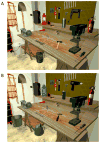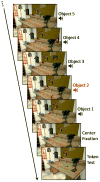The strategic retention of task-relevant objects in visual working memory
- PMID: 22845068
- PMCID: PMC3855846
- DOI: 10.1037/a0029496
The strategic retention of task-relevant objects in visual working memory
Abstract
The serial and spatially extended nature of many real-world visual tasks suggests the need for control over the content of visual working memory (VWM). We examined the management of VWM in a task that required participants to prioritize individual objects for retention during scene viewing. There were 5 principal findings: (a) Strategic retention of task-relevant objects was effective and was dissociable from the current locus of visual attention; (b) strategic retention was implemented by protection from interference rather than by preferential encoding; (c) this prioritization was flexibly transferred to a new object as task demands changed; (d) no-longer-relevant items were efficiently eliminated from VWM; and (e) despite this level of control, attended and fixated objects were consolidated into VWM regardless of task relevance. These results are consistent with a model of VWM control in which each fixated object is automatically encoded into VWM, replacing a portion of the content in VWM. However, task-relevant objects can be selectively protected from replacement.
Figures









Similar articles
-
Amodal completion in visual working memory.J Exp Psychol Hum Percept Perform. 2016 Sep;42(9):1344-53. doi: 10.1037/xhp0000231. Epub 2016 Mar 28. J Exp Psychol Hum Percept Perform. 2016. PMID: 27019119
-
The neural correlates of visual working memory encoding: a time-resolved fMRI study.Neuropsychologia. 2011 May;49(6):1527-36. doi: 10.1016/j.neuropsychologia.2011.01.040. Epub 2011 Feb 15. Neuropsychologia. 2011. PMID: 21315091 Free PMC article.
-
α Power Modulation and Event-Related Slow Wave Provide Dissociable Correlates of Visual Working Memory.J Neurosci. 2015 Oct 14;35(41):14009-16. doi: 10.1523/JNEUROSCI.5003-14.2015. J Neurosci. 2015. PMID: 26468201 Free PMC article.
-
Selective visual processing across competition episodes: a theory of task-driven visual attention and working memory.Philos Trans R Soc Lond B Biol Sci. 2013 Sep 9;368(1628):20130060. doi: 10.1098/rstb.2013.0060. Print 2013 Oct 19. Philos Trans R Soc Lond B Biol Sci. 2013. PMID: 24018722 Free PMC article. Review.
-
The contralateral delay activity as a neural measure of visual working memory.Neurosci Biobehav Rev. 2016 Mar;62:100-8. doi: 10.1016/j.neubiorev.2016.01.003. Epub 2016 Jan 21. Neurosci Biobehav Rev. 2016. PMID: 26802451 Free PMC article. Review.
Cited by
-
Selective maintenance of value information helps resolve the exploration/exploitation dilemma.Cognition. 2019 Feb;183:226-243. doi: 10.1016/j.cognition.2018.11.004. Epub 2018 Nov 28. Cognition. 2019. PMID: 30502584 Free PMC article.
-
Working memory is updated by reallocation of resources from obsolete to new items.Atten Percept Psychophys. 2023 Jul;85(5):1437-1451. doi: 10.3758/s13414-022-02584-2. Epub 2022 Oct 17. Atten Percept Psychophys. 2023. PMID: 36253588 Free PMC article.
-
Retrieval from long-term memory does not bypass working memory.Atten Percept Psychophys. 2025 Aug 22. doi: 10.3758/s13414-025-03145-z. Online ahead of print. Atten Percept Psychophys. 2025. PMID: 40846824
-
Using electrophysiology to demonstrate that cueing affects long-term memory storage over the short term.Psychon Bull Rev. 2015 Oct;22(5):1349-57. doi: 10.3758/s13423-015-0799-2. Psychon Bull Rev. 2015. PMID: 25604772 Free PMC article.
-
Retro-cue benefits in working memory without sustained focal attention.Mem Cognit. 2014 Jul;42(5):712-28. doi: 10.3758/s13421-013-0392-8. Mem Cognit. 2014. PMID: 24442551
References
MeSH terms
Grants and funding
LinkOut - more resources
Full Text Sources
Other Literature Sources

